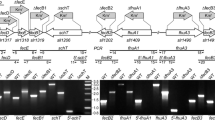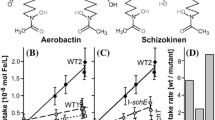Abstract
In Gram-negative bacteria, transport of ferric siderophores through outer membrane is a complex process that requires specific outer membrane transporters and energy-transducing TonB–ExbB–ExbD system in the cytoplasmic membrane. The genome of the non-siderophore-producing cyanobacterium Synechocystis sp. PCC 6803 encodes all putative components of the siderophore-mediated iron uptake system. So far, there has been no experimental evidence for the existence of such a pathway in this organism. On the contrary, its reductive iron uptake pathway has been studied in detail. We demonstrate that Synechocystis sp. PCC 6803 is capable of using dihydroxamate xenosiderophores, either ferric schizokinen (FeSK) or a siderophore of the filamentous cyanobacterium Anabaena variabilis ATCC 29413 (SAV), as the sole source of iron. Inactivation of the tonB gene or the exbB1–exbD1 gene cluster resulted in an inability to utilize these siderophores. At the same time, the inactivation of the feoB gene encoding FeoB plasma membrane ferrous iron transporter, or one of the futB or futC genes encoding permease and ATPase subunit of FutABC ferric iron transporter, did not impair the ability of cells to utilize FeSK or SAV as the sole source of iron for growth. Our data suggest that cyanobacterium Synechocystis sp. PCC 6803 is capable of acquiring iron–siderophore complexes in a TonB-dependent manner without iron reduction in the periplasm.


Similar content being viewed by others
References
Alexander DB, Zuberer DA (1991) Use of chrome azurol S reagents to evaluate siderophore production by rhizosphere bacteria. Biol Fertil Soil 12:39–45. doi:10.1007/BF00369386
Braun V, Hantke K (2011) Recent insights into iron import by bacteria. Curr Opin Chem Biol 15:328–334. doi:10.1016/j.cbpa.2011.01.005
Cornell RM, Schwertmann U (2006) The iron oxides: structure, properties, reactions, occurrences and uses, 2nd edn. Wiley, Hoboken
Ehrenreich IM, Waterbury JB, Webb EA (2005) Distribution and diversity of natural product genes in marine and freshwater cyanobacterial cultures and genomes. Appl Environ Microbiol 71:7401–7413. doi:10.1128/AEM.71.11.7401-7413.2005
Fischer E, Günter K, Braun V (1989) Involvement of ExbB and TonB in transport across the outer membrane of Escherichia coli: phenotypic complementation of Exb mutants by overexpressed TonB and physical stabilization of TonB by ExbB. J Bacteriol 171:5127–5134. doi:10.1128/jb.171.9.5127-5134.1989
Frausto da Silva JJR, Williams RJP (2001) The biological chemistry of the elements: the inorganic chemistry of life, 2nd edn. University Press, Oxford
Fujii M, Rose AL, Waite TD (2011) Iron uptake by toxic and nontoxic strains of Microcystis aeruginosa. Appl Environ Microbiol 77:7068–7071. doi:10.1128/AEM.05270-11
Fujii M, Yeung ACY, Waite TD (2015) Competitive effects of calcium and magnesium ions on the photochemical transformation and associated cellular uptake of iron by the fresh water cyanobacterial phytoplankton Microcystis aeruginosa. Environ Sci Technol 49:9133–9142. doi:10.1021/acs.est.5b01583
Gough J, Murray N (1983) Sequence diversity among related genes for recognition of specific targets in DNA molecules. J Mol Biol 166:1–19. doi:10.1016/S0022-2836(83)80047-3
Hopkinson BM, Morel FMM (2009) The role of siderophores in iron acquisition by photosynthetic marine microorganisms. Biometals 22:659–669. doi:10.1007/s10534-009-9235-2
Huang F, Parmryd I, Nilsson F, Persson AL, Pakrasi HB, Andersson B, Norling B (2002) Proteomics of Synechocystis sp. strain PCC 6803: identification of plasma membrane proteins. Mol Cell Proteom 1:956–966. doi:10.1074/mcp.M200043-MCP200
Imai A, Fukushima T, Matsushige K (1999) Effect of iron limitation and aquatic humic substances on the growth of Microcystis aeruginosa. Can J Fish Aquat Sci 56:1929–1937. doi:10.1139/f99-131
Jiang HB, Lou WJ, Du HY, Price NM, Qiu BS (2012) Sll1263, a unique cation diffusion facilitator protein that promotes iron uptake in the cyanobacterium Synechocystis sp. strain PCC 6803. Plant Cell Physiol 53:1404–1417. doi:10.1093/pcp/pcs086
Jiang HB, Lou WJ, Ke WT, Song WY, Price NM, Qiu BS (2015) New insights into iron acquisition by cyanobacteria: an essential role for ExbB-ExbD complex in inorganic iron uptake. ISME J 9:297–309. doi:10.1038/ismej.2014.123
Katoh H, Hagino N, Grossman AR, Ogawa T (2001) Genes essential to iron transport in the cyanobacterium Synechocystis sp. strain PCC 6803. J Bacteriol 183:2779–2784. doi:10.1128/JB.183.9.2779-2784.2001
Kopf M, Klähn S, Scholz I, Matthiessen JKF, Hess WR, Voß B (2014) Comparative analysis of the primary transcriptome of Synechocystis sp. PCC 6803. DNA Res 21:527–539. doi:10.1093/dnares/dsu018
Köster W (2001) ABC transporter mediated uptake of iron, siderophores, heme and vitamin B12. Res Microbiol 152:291–301. doi:10.1016/S0923-2508(01)01200-1
Kranzler C, Lis H, Finkel OM, Schmetterer G, Shaked Y, Keren N (2014) Coordinated transporter activity shapes high-affinity iron acquisition in cyanobacteria. ISME J 8:409–417. doi:10.1038/ismej.2013.161
Kranzler C, Lis H, Shaked Y, Keren N (2011) The role of reduction in iron uptake processes in a unicellular, planktonic cyanobacterium. Environ Microbiol 13:2990–2999. doi:10.1111/j.1462-2920.2011.02572.x
Kranzler C, Rudolf M, Keren N, Schleiff E (2013) Iron in cyanobacteria. In: Chauvat F, Cassier-Chauvat C (eds) Advance in botanical research 65: genomics of cyanobacteria. Elsevier Ltd, Amsterdam, pp 57–105
Lis H, Kranzler C, Keren N, Shaked Y (2015) A comparative study of iron uptake rates and mechanisms amongst marine and fresh water cyanobacteria: prevalence of reductive iron uptake. Life 5:841–860. doi:10.3390/life5010841
Lis H, Shaked Y (2009) Probing the bioavailability of organically bound iron: a case study in the Synechococcus-rich waters of the gulf of aqaba. Aquat Microb Ecol 56:241–253. doi:10.3354/ame01347
Lis H, Shaked Y, Kranzler C, Keren N, Morel FMM (2015) Iron bioavailability to phytoplankton: an empirical approach. ISME J 9:1003–1013. doi:10.1038/ismej.2014.199
Martin JH, Gordon RM, Fitzwater SE, Martin H (1991) The case for iron. Limnol Oceanogr 36:1793–1802. doi:10.4319/lo.1991.36.8.1793
Mirus O, Strauss S, Nicolaisen K, Von Haeseler A, Schleiff E (2009) TonB-dependent transporters and their occurrence in cyanobacteria. BMC Biol 7:68. doi:10.1186/1741-7007-7-68
Nagai T, Imai A, Matsushige K, Yokoi K, Fukushima T (2004) Voltammetric determination of dissolved iron and its speciation in freshwater. Limnol 5:87–94. doi:10.1007/s10201-004-0121-x
Neilands JB (1995) Siderophores: structure and function of microbial iron transport compounds. J Biol Chem 270:26723–26726. doi:10.1074/jbc.270.45.26723
Nicolaisen K, Moslavac S, Samborski A, Valdebenito M, Hantke K, Maldener I, Muro-Pastor AM, Flores E, Schleiff E (2008) Alr0397 is an outer membrane transporter for the siderophore schizokinen in Anabaena sp. strain PCC 7120. J Bacteriol 190:7500–7507. doi:10.1128/JB.01062-08
Nikawa J, Kawabata M (1998) PCR- and ligation-mediated synthesis of marker cassettes with long flanking homology regions for gene disruption in Saccharomyces cerevisiae. Nucleic Acids Res 26:860–861. doi:10.1093/nar/26.3.860
Prentki P, Krisch HM (1984) In vitro insertional mutagenesis with a selectable DNA fragment. Gene 29:303–313. doi:10.1016/0378-1119(84)90059-3
Rose AL, Salmon TP, Lukondeh T, Neilan BA, Waite TD (2005) Use of superoxide as an electron shuttle for iron acquisition by the marine cyanobacterium Lyngbya majuscula. Environ Sci Technol 39:3708–3715. doi:10.1021/es048766c
Rudolf M, Kranzler C, Lis H, Margulis K, Stevanovic M, Keren N, Schleiff E (2015) Multiple modes of iron uptake by the filamentous, siderophore-producing cyanobacterium, Anabaena sp. PCC 7120. Mol Microbiol 97:577–588. doi:10.1111/mmi.13049
Rudolf M, Stevanovic M, Kranzler C, Pernil R, Keren N, Schleiff E (2016) Multiplicity and specificity of siderophore uptake in the cyanobacterium Anabaena sp. PCC 7120. Plant Mol Biol 92:57–69. doi:10.1007/s11103-016-0495-2
Schweizer HP (1993) Small broad-host-range gentamycin resistance gene cassettes for site-specific insertion and deletion mutagenesis. Biotechniques 15:831–833
Shaked Y, Lis H (2012) Disassembling iron availability to phytoplankton. Front Microbiol 3:1–26. doi:10.3389/fmicb.2012.00123
Shcolnick S, Shaked Y, Keren N (2007) A role for mrgA, a DPS family protein, in the internal transport of Fe in the cyanobacterium Synechocystis sp. PCC6803. Biochim Biophys Acta 1767:814–819. doi:10.1016/j.bbabio.2006.11.015
Stevanovic M, Hahn A, Nicolaisen K, Mirus O, Schleiff E (2012) The components of the putative iron transport system in the cyanobacterium Anabaena sp. PCC 7120. Environ Microbiol 14:1655–1670. doi:10.1111/j.1462-2920.2011.02619.x
Suzuki I, Kanesaki Y, Mikami K, Kanehisa M, Murata N (2001) Cold-regulated genes under control of the cold sensor Hik33 in Synechocystis. Mol Microbiol 40:235–244. doi:10.1046/j.1365-2958.2001.02379.x
Trick CG, Kerry A (1992) Isolation and purification of siderophores produced by cyanobacteria, Synechococcus sp. PCC 7942 and Anabaena variabilis ATCC 29413. Curr Microbiol 24:241–245. doi:10.1007/bf01577326
Twiss MR, Auclair JC, Charlton MN (2000) An investigation into iron-stimulated phytoplankton productivity in epi-pelagic lake Erie during thermal stratification using trace metal clean techniques. Can J Fish Aquat Sci 57:86–95. doi:10.1139/f99-189
Vraspir JM, Butler A (2009) Chemistry of marine ligands and siderophores. Annu Rev Mar Sci 1:43–63. doi:10.1146/annurev.marine.010908.163712
Wilhelm SW, Trick CG (1994) Iron-limited growth of cyanobacteria: multiple siderophore production is a common response. Limnol Oceanogr 39:1979–1984. doi:10.4319/lo.1994.39.8.1979
Xu H, Qiu GW, Lou WG, Li ZK, Jiang HB, Price NM, Qiu BS (2016) Identification of an iron permease, cFTR1, in cyanobacteria involved in the iron reduction/re-oxidation uptake pathway. Environ Microbiol 18:5005–5017. doi:10.1111/1462-2920.13464
Xu H, Zhu G, Qin B, Paerl HW (2013) Growth response of Microcystis spp. to iron enrichment in different regions of lake Taihu, China. Hydrobiologia 700:187–202. doi:10.1007/s10750-012-1229-3
Acknowledgements
We thank Dr. Lidia E. Mikheeva for kindly providing strain of Anabaena variabilis and Dr. Igor B. Kaplan for critically reading the manuscript. This work was supported by the Russian Foundation for Basic Research (Project 13-04-01767).
Author information
Authors and Affiliations
Corresponding author
Ethics declarations
Conflict of interest
The authors declare that they have no conflict of interest.
Electronic supplementary material
Below is the link to the electronic supplementary material.
Rights and permissions
About this article
Cite this article
Babykin, M.M., Obando, T.S.A. & Zinchenko, V.V. TonB-Dependent Utilization of Dihydroxamate Xenosiderophores in Synechocystis sp. PCC 6803. Curr Microbiol 75, 117–123 (2018). https://doi.org/10.1007/s00284-017-1355-2
Received:
Accepted:
Published:
Issue Date:
DOI: https://doi.org/10.1007/s00284-017-1355-2




